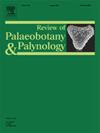Chemosystematic studies of Devonian coal-forming plants: Barzas Orestovia-like plants compressions
IF 1.7
3区 地球科学
Q2 PALEONTOLOGY
引用次数: 0
Abstract
Orestovia-like plants are of great scientific and practical interest for various fields of natural science, forming the most ancient unique Devonian Barzas coals in the Kuznetsk Basin, Russia. However their natural affinity (higher plants or algae) remains disputable. This work studies Barzas compressions of Orestovia-like plants from the standpoint of chemosystematics. We proposed to use the aromatic biopolymer lignin, which is included in all higher terrestrial plants, as a marker of organic matter. To prove the presence of lignin and establish its structure, a complex of physical and chemical methods was used: FTIR and EPR spectroscopy, pyrolytic gas chromatography–mass spectrometry, scanning electron microscopy, X-ray fluorescence and X-ray phase analysis. Based on the obtained results, we found the presence of transformation products of compositionally homogeneous p-coumaric protolignin in the substance of plant remains. The obtained data do not exclude the validity of the hypothesis that the Devonian Orestovia-like plants belong to higher plants.

泥盆纪造煤植物的化学系统研究:Barzas orestovia样植物压缩
orestova类植物在自然科学的各个领域具有重要的科学和实用价值,在俄罗斯库兹涅茨克盆地形成了最古老独特的泥盆纪Barzas煤。然而,它们的天然亲和力(高等植物或藻类)仍有争议。本文从化学系统学的角度研究了orestovia类植物的Barzas压缩。我们建议使用所有高等陆生植物中都含有的芳香族生物聚合物木质素作为有机质的标记物。为了证明木质素的存在并确定其结构,采用了一系列物理和化学方法:FTIR和EPR光谱、热解气相色谱-质谱、扫描电镜、x射线荧光和x射线相分析。在此基础上,我们发现在植物残体物质中存在组成均质的对香豆素原木质素转化产物。获得的数据并不排除泥盆纪orestovia类植物属于高等植物的假设的有效性。
本文章由计算机程序翻译,如有差异,请以英文原文为准。
求助全文
约1分钟内获得全文
求助全文
来源期刊
CiteScore
3.50
自引率
21.10%
发文量
149
审稿时长
6 months
期刊介绍:
The Review of Palaeobotany and Palynology is an international journal for articles in all fields of palaeobotany and palynology dealing with all groups, ranging from marine palynomorphs to higher land plants. Original contributions and comprehensive review papers should appeal to an international audience. Typical topics include but are not restricted to systematics, evolution, palaeobiology, palaeoecology, biostratigraphy, biochronology, palaeoclimatology, paleogeography, taphonomy, palaeoenvironmental reconstructions, vegetation history, and practical applications of palaeobotany and palynology, e.g. in coal and petroleum geology and archaeology. The journal especially encourages the publication of articles in which palaeobotany and palynology are applied for solving fundamental geological and biological problems as well as innovative and interdisciplinary approaches.

 求助内容:
求助内容: 应助结果提醒方式:
应助结果提醒方式:


